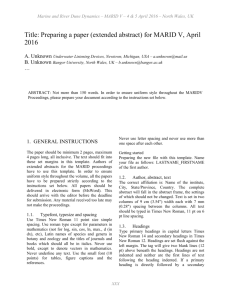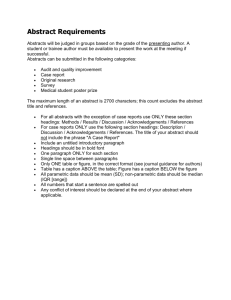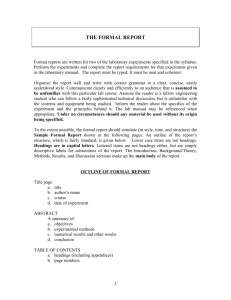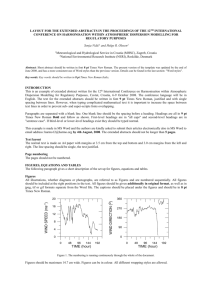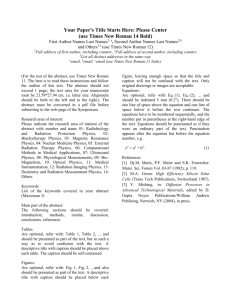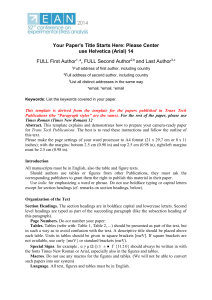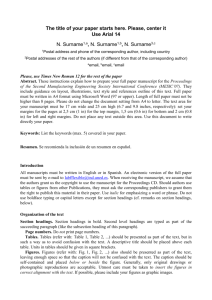Preparing a paper for MARID IV
advertisement
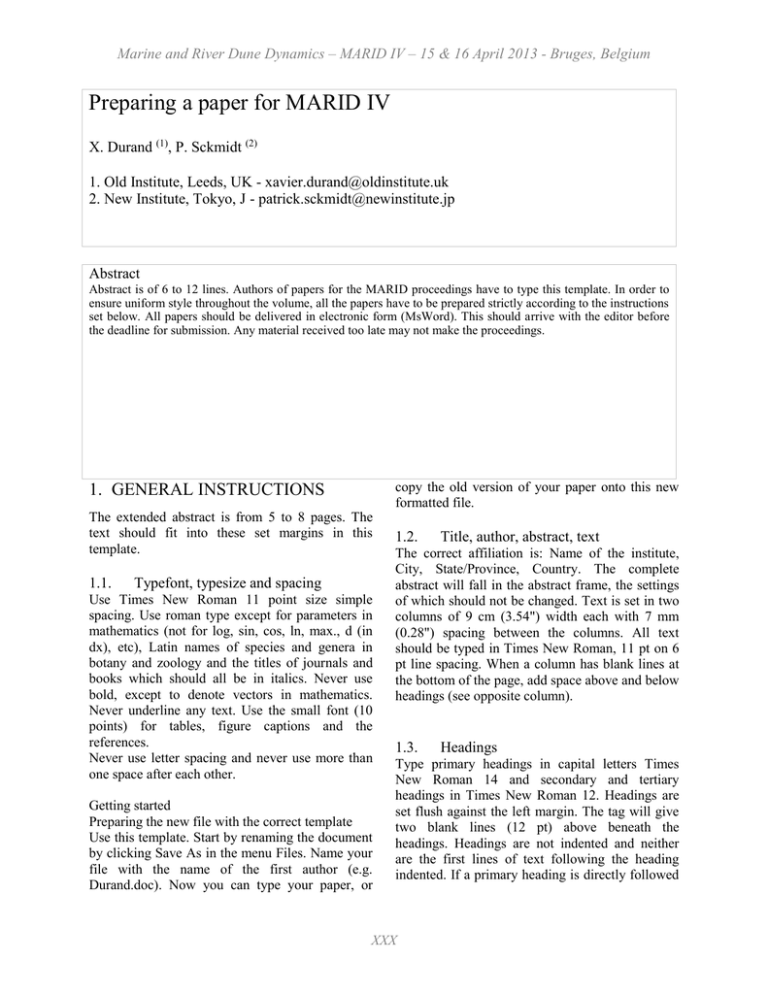
Marine and River Dune Dynamics – MARID IV – 15 & 16 April 2013 - Bruges, Belgium Preparing a paper for MARID IV X. Durand (1), P. Sckmidt (2) 1. Old Institute, Leeds, UK - xavier.durand@oldinstitute.uk 2. New Institute, Tokyo, J - patrick.sckmidt@newinstitute.jp Abstract Abstract is of 6 to 12 lines. Authors of papers for the MARID proceedings have to type this template. In order to ensure uniform style throughout the volume, all the papers have to be prepared strictly according to the instructions set below. All papers should be delivered in electronic form (MsWord). This should arrive with the editor before the deadline for submission. Any material received too late may not make the proceedings. 1. GENERAL INSTRUCTIONS copy the old version of your paper onto this new formatted file. The extended abstract is from 5 to 8 pages. The text should fit into these set margins in this template. 1.2. 1.1. Typefont, typesize and spacing Use Times New Roman 11 point size simple spacing. Use roman type except for parameters in mathematics (not for log, sin, cos, ln, max., d (in dx), etc), Latin names of species and genera in botany and zoology and the titles of journals and books which should all be in italics. Never use bold, except to denote vectors in mathematics. Never underline any text. Use the small font (10 points) for tables, figure captions and the references. Never use letter spacing and never use more than one space after each other. Getting started Preparing the new file with the correct template Use this template. Start by renaming the document by clicking Save As in the menu Files. Name your file with the name of the first author (e.g. Durand.doc). Now you can type your paper, or Title, author, abstract, text The correct affiliation is: Name of the institute, City, State/Province, Country. The complete abstract will fall in the abstract frame, the settings of which should not be changed. Text is set in two columns of 9 cm (3.54") width each with 7 mm (0.28") spacing between the columns. All text should be typed in Times New Roman, 11 pt on 6 pt line spacing. When a column has blank lines at the bottom of the page, add space above and below headings (see opposite column). 1.3. Headings Type primary headings in capital letters Times New Roman 14 and secondary and tertiary headings in Times New Roman 12. Headings are set flush against the left margin. The tag will give two blank lines (12 pt) above beneath the headings. Headings are not indented and neither are the first lines of text following the heading indented. If a primary heading is directly followed XXX Marine and River Dune Dynamics – MARID IV – 15 & 16 April 2013 - Bruges, Belgium by a secondary heading, only a blank line should be set between the two headings. 1.4. Photographs will be scanned by the printer. Always supply original photographs. Equations Use the equation editor of the selected word processing program. Equations are not indented. Number equations consecutively and place the number with the tab key at the end of the line, between parantheses. Refer to equations by these numbers. See for example Equation 1 below: From the above we note that sin = (x + y)z or: Kt 1 ca tan R2 4 k1 (1) where ca = interface adhesion; = friction angle at interface; and k1 = shear stiffness number. For simple equations in the text always use superscript and subscript. Do not use the equation editor between text on same line. The inline equations (equations within a sentence) in the text will automatically be converted to the AMS notation standard. 1.5. Tables and figures Locate tables close to the first reference to them in the text and number them consecutively. Avoid abbreviations in column headings. Indicate units in the line immediately below the heading. Explanations should be given at the foot of the table, not within the table itself. For simple tables use the tab key and not the table option. Type all text in tables in small type: 10 points. Align all headings to the left of their column and start these headings with an initial capital. Type the caption above the table to the same width as the table (Table caption tag). See for example Table 1. Always use the Figure caption style 10 points size. Place the caption underneath the figure. Type as follows: ‘Figure 1. Caption.’ Leave about two lines of space between the figure caption and the text of the paper. Except for the large figures which must be put at the end of the paper, please number and place figures consecutively in the order in which reference is made to them in the text, making no distinction between figures and photographs. Normal figures should fit within the column width. Figures, photographs, etc. can be in black/white or full color, but will be probably produced in the book in black/white only. Figure 1. Caption of a typical figure. Do not place figures sideways on a page. Figures, etc. should not be centered, but placed against the left margin. Leave about two lines of space between the actual text and figure (including caption). Keep figures as simple as possible. Avoid excessive notes and designations. Photographs should be with good contrast. The proceedings will be printed in grayscale. For this reason avoid the use of colour in figures and photographs. Always use the official SI notations: kg / m / kJ / mm instead of kg. (Kg) / m. / kJ. (KJ) / mm.; 20°1632SW instead of 20° 16 32 SW 0.50 instead of 0,50 (used in French text); 9000 instead of 9,000 but if more than 10,000: 10,000 instead of 10000 14C instead of C14 / C-14 and BP / BC / AD instead of B.P. / B.C. / A.D. × 20 instead of 20 / X20 / x 20; 4 + 5 > 7 instead of 4+5>7 but –8 / +8 instead of – 8 / + 8 e.g. / i.e. instead of e.g., / i.e., 2. CONCLUSIONS Conclusions should state concisely the most important propositions of the paper as well as the XXX Marine and River Dune Dynamics – MARID IV – 15 & 16 April 2013 - Bruges, Belgium author’s views of the practical implications of the results. Keep conclusions brief and to the point. Larch, A.A. 1997. Computer ... Larch, A.A. & Jensen, M.C. 1996. Effects of ... Larch, A.A. & Smith, B.P. 1993. Alpine 3. Typography for references ACKNOWLEDGMENT The author is grateful to .... 4. REFERENCES In the text, place the authors’ last names without initials and the date of publication in parentheses. At the end of the paper, list all references in alphabetical order underneath the heading REFERENCES. The references should be typed in Time New Roman 10 pt. If several works by the same author are cited, entries should be chronological: Larch, A.A. 1996a. Development ... Larch, A.A. 1996b. Facilities ... Last name, Initials. Year. Title of article. Title of Journal (series number if necessary) volume number (issue number if necessary): page numbers. Grove, A.T. 1980. Geomorphic evolution of the Sahara and the Nile. In M.A.J. Williams & H. Faure (eds), The Sahara and the Nile: 21-35. Rotterdam: Balkema. Jappelli, R. & Marconi, N. 1997. Recommendations and prejudices in the realm of foundation engineering in Italy: A historical review. In Carlo Viggiani (ed.), Geotechnical engineering for the preservation of monuments and historical sites; Proc. intern. symp., Napoli, 3-4 October 1996. Rotterdam: Balkema. Johnson, H.L. 1965. Artistic development in autistic children. Child Development 65(1): 13-16. Figure 2. Place the large figures at the end of the paper. XXX
